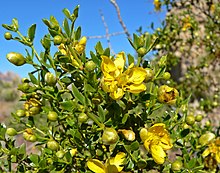Desert plant
A desert plant or eremophyte ( ancient Greek ἐρη̃μος erémos "desert" and φυτόν phytón "plant") is a plant that grows in a semi-desert or desert , whereby the cold deserts are not taken into account. In the Paläotropis species-rich representatives are the families Crassulaceae , Aizoaceae , Asclepiadaceae and Euphorbiaceae , in the Neotropis the Cactaceae , Agavaceae and the Bromeliaceae . The most important site factors are drought and high temperatures. The most common forms of life are the therophytes , geophytes , xerophytes and succulents .
dryness
Not all desert plants are dry plants, i.e. xerophytes. There are various adaptations to deal with the drought in desert areas. The individual groups can be well characterized, but have no characteristics that are common to all.
- Many plant species avoid dry periods by surviving them as seeds (therophytes) or in the form of underground perennial organs such as onions (geophytes). However, geophytes only occur in areas where there is at least fairly regular rainfall, for example in the northern fringes of the Sahara to the Mediterranean. After a rain the seeds or the organs of persistence drift quickly. The therophytes can complete their entire life cycle in six to eight weeks.
- In addition to algae and lichens, which are obligatorily tolerant to dehydration, there are also a few representatives of vascular plants in the deserts that can dry out without being damaged ( alternating moisture or poikilohydric plants). They are often referred to as "resurrection plants". Examples are the fern Plecopteris polypodioides in the USA or Myrothamnus flabellifolia in Southwest Africa.


- Many plants are able to regulate their water balance in such a way that they can remain photosynthetically active even during dry periods.
- Xerophytes, or dry plants, have leaves that minimize water loss. They do not grow during dry periods, but are only partially in a dormant state.
- Phreatophytes reach the groundwater with their roots and thus have enough water. Representatives are about the tamarisk and acacia in Africa or Prosopis in America. Most of them are trees, their roots reach up to 50 m deep. Their biggest problem is establishing themselves, as their roots have to penetrate the often hard ground until they have a secure water supply. Therefore phreatophytes mostly occur along periodic rivers, where the soil is moist and softened for a long time after rainfall. With the exception of their roots, they are no different from plants in humid areas.
- Some plants, such as the creosote bush , form a branching root system directly below the surface of the soil with which they can absorb precipitation.
- In foggy deserts such as Chile and Peru, plants up to the size of a tree “comb out” the mist that falls from the leaves to the ground and is then absorbed by the roots. Desert lichens like Rocella, the morning mist is enough to hydrate and photosynthesize. When the heat of the day increases, they dry out again and roll up. Bromeliads have their own suction scales with which they can absorb water.
- The most famous form are the succulents . They store water after rainfall so that it can be used during dry periods. The trunks ( cacti , euphorbias ), leaves ( agaves ), but also roots or tubers are used for storage . Extreme representatives are the "living stones" from the Mesembryanthemaceae family such as Lithops , whose fleshy leaves are almost completely sunk into the ground.

Connected to the succulence is a special form of photosynthesis , the Crassulacean acid metabolism : here is the inclusion of carbon dioxide transferred for photosynthesis in the night when the water loss in open stomata is substantially less than during the day.
Many species only grow in deserts in places with sufficient water supply, such as in oases . They have a high degree of perspiration , which prevents the leaves from overheating, such as the cucurbitaceae . In shady sources of grow maidenhair ( Adiantum capillus-veneris ) and fig trees ( Ficus spp.).
Overall, the water supply for plants in deserts, based on the leaf area per m² of soil area, is no worse than in other areas. In return, the vegetation is accordingly sparse ( contracted vegetation ).
The halophytes grow on saline sites, which are quite common in deserts .
temperature
The soil surface temperature in deserts often reaches 80 ° C, even desert plants are damaged at over 60 ° C. The option of transpiration cooling is not available to most desert plants due to lack of water. With their ribs, succulents facilitate heat exchange with the environment (cooling rib principle). The stilt plants in Australia, such as Stylidium, have elongated shoots that lift the turf-shaped plant a few inches outside of the most heated area. Poikilohydrie is also an evasive strategy against high temperatures: lichens that die hydrogenated at 40 ° C, survive dry 100 ° C.
Lower plants
In addition to vascular plants, algae and lichens also play a role as producers in the deserts. Lichen only occurs in deserts, where they are more frequently wetted by dew or fog. Algae are widespread but hardly studied, but the cyanobacteria predominate . They form thin coatings on the surface or dense colonies. Cryptoendolitic lichens, some cyanobacteria and algae live in the rock, sometimes several millimeters below the surface.
Individual evidence
- ^ Matthias Schaefer: Dictionary of Ecology . 4th edition, Spektrum Akademischer Verlag, Heidelberg, Berlin 2003, p. 384. ISBN 3-8274-0167-4
supporting documents
- H. Walter , S.-W. Breckle: Ecology of the Earth. Volume 2: Special ecology of the tropical and subtropical zones. 3rd edition, Elsevier, Munich 2004, pp. 371–373. ISBN 3-8274-0789-3
- Georg Grabherr: Color Atlas of Earth's Ecosystems . Ulmer, Stuttgart 1997, pp. 150-157. ISBN 3-8001-3489-6
- Roland Ennos, Elizabeth Sheffield: Plant Life . Blackwell, Oxford 2000, pp. 161-166. ISBN 0-86542-737-2
